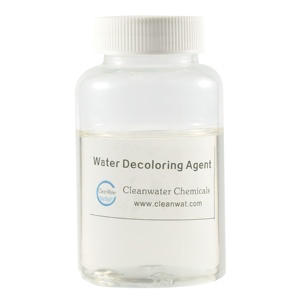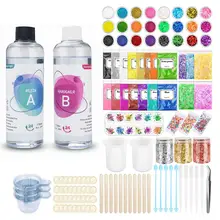A water decoloring agent is a chemical concoction engineered for widespread use across various sectors to strip color from wastewater and other aqueous sources. This decolorization process is essential for upholding environmental norms and guaranteeing water quality for industrial applications. Alibaba.com presents an extensive array of water decoloring agents to meet a plethora of industrial needs.
Types and Characteristics of Water Decoloring Agents
The spectrum of water decoloring agents encompasses a variety of formulations, each designed to overcome specific decolorization challenges. Certain agents are crafted to neutralize the vivid colors of synthetic dyes in the effluent from textile production, while others excel at mitigating the subtler shades derived from organic materials in paper and pulp mill discharges. The LSD-01 Decolorant Polymer, with its potent 50% concentration, is particularly effective for heavy-duty applications, adept at managing substantial quantities of industrial dyes and pigments. The BWD-01 water decoloring agent is also notable for its wide-ranging effectiveness, adept at tackling an array of color-inducing impurities across various pH levels.
Structure and Operation of Water Decoloring Agents
The sophisticated architecture of a water decoloring agent represents a triumph of chemical engineering, optimized for peak decolorization performance. These agents feature active sites specifically designed to latch onto and neutralize chromophores—the molecular segments responsible for coloration. Typically, they consist of a harmonious mixture of coagulants and flocculants. The coagulants possess a charge that counteracts the charged dye molecules, thus destabilizing them. The flocculants, generally long-chain polymers, then clump these destabilized molecules together into larger aggregates. These aggregates can then be more easily separated from the water, either by natural sedimentation or through filtration, culminating the decolorization process.
Materials and Properties of Decoloring Agents
The constituents of water decoloring agents are selected for their reactive capabilities and adherence to environmental safety protocols. Activated carbon, often sourced from renewable materials like coconut husks or coal, is favored for its porous nature and expansive surface area, which affords superior adsorption of organic compounds. Engineered synthetic polymers, such as those in BWD-01, are tailored to enhance the flocculation process, efficiently ensnaring color particles. These substances are chosen not only for their decolorization prowess but also for their environmental benignity, ensuring they do not introduce further pollutants into the aquatic system.
Business Usages and Applications of Decoloring Agents
Decoloring agent water treatment is indispensable across a broad range of industries. In the textile realm, these agents are crucial for purifying dye-rich wastewater prior to environmental discharge or internal reuse. Within the petroleum sector, decoloring agents are central to refining process water, which can then be recycled, diminishing the need for fresh water and aiding in water conservation initiatives. Utilizing these agents not only aids companies in adhering to environmental mandates but also bolsters the efficacy of water treatment systems, potentially leading to cost reductions and heightened sustainability.
Functions of Water Decoloring Agents
The principal role of a water decoloring agent is to confront and eradicate color from wastewater, a task that involves several intricate mechanisms. Adsorption is the initial phase, wherein the agent binds with the color-inducing particles. This is succeeded by flocculation, the gathering of these particles into larger clusters that can be extracted from the water. Beyond color removal, these agents frequently serve additional roles such as diminishing Chemical Oxygen Demand (COD) and Biological Oxygen Demand (BOD) levels, thereby enhancing the overall water quality.
Features of BWD-01 Water Decoloring Agent
The BWD-01 water decoloring agent stands out for its array of salient features. Its prowess in eliminating color is complemented by its adaptability, proving effective across a spectrum of pH environments, suitable for a variety of industrial uses. Another notable attribute is its formulation that aims to reduce sludge production during treatment. This not only eases waste management but also lessens the environmental toll of sludge disposal, a considerable boon for businesses striving to bolster their eco-friendly image.
Benefits of Using Decoloring Agents
The advantages of deploying water decoloring agents are numerous. They facilitate industry compliance with rigorous environmental standards, thus averting potential penalties. The agents also promote increased rates of water recycling, a critical aspect for water-intensive sectors aiming to curtail their water footprint. By refining the quality of effluent, these agents also safeguard ecosystems where the water is ultimately released, ensuring the vitality of local aquatic habitats.
How to Use Water Decoloring Agents
Effective application of a water decoloring agent necessitates following the manufacturer's instructions. The agent's dosage should be tailored to the specific attributes of the wastewater under treatment. Thorough mixing is crucial to guarantee uniform dispersion of the agent in the water. Post-treatment, the water should be allowed to settle or be processed via a filtration system to eliminate the flocs that now contain the aggregated color particles.
How to Choose the Right Water Decoloring Agent
Choosing the correct water decoloring agent is a pivotal decision that depends on a thorough understanding of your water treatment system's specific needs. Considerations such as the characteristics of the wastewater, the types of dyes or pigments involved, and the desired quality of the treated water are essential. It is equally important to verify that the selected agent is compatible with other treatment chemicals and processes employed at the facility.
How to Clean and Maintain Water Treatment Systems Using Decoloring Agents
For water treatment systems that incorporate decoloring agents, consistent maintenance is essential for sustained effectiveness. This includes regular performance evaluations, timely replacement of exhausted materials, and adherence to cleaning protocols. Proper upkeep not only extends the lifespan of the water treatment system but also ensures its continued operational efficiency.
How does a water decoloring agent work?
Water decoloring agents function through an intricate mechanism of adsorption and neutralization of charged particles. The active ingredients within the agent attach to the color-causing substances in the water, neutralizing their charge and prompting aggregation. This process enables the straightforward removal of these substances via sedimentation or filtration, yielding transparent, color-free water.
What industries benefit most from water decoloring agents?
Industries producing colored wastewater are the prime beneficiaries of water decoloring agents. Textile mills, dye producers, paper and pulp factories, and chemical plants are among the chief users. By employing decoloring agents, these sectors can comply with wastewater discharge regulations and mitigate their environmental footprint.
Are water decoloring agents safe for the environment?
Environmental stewardship is a cornerstone for water decoloring agent manufacturers. Formulations like BWD-01 are designed to break down into innocuous substances post-treatment, minimizing potential ecological impacts. Nevertheless, it is imperative for industries to apply these agents in line with prescribed guidelines to ensure environmental preservation.









































 浙公网安备 33010002000092号
浙公网安备 33010002000092号 浙B2-20120091-4
浙B2-20120091-4